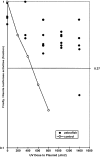DNA repair capacity of zebrafish
- PMID: 17686971
- PMCID: PMC1948947
- DOI: 10.1073/pnas.0706157104
DNA repair capacity of zebrafish
Abstract
Damage to the genome is unavoidable in living creatures, because of sunlight exposure as well as environmental chemicals present in food and drinking water. There is a need to monitor and purify the drinking water; therefore, several methods of detection have been developed. A very promising model system for this purpose is the zebrafish (Danio rerio), which is endowed with special qualities for detecting external as well as internal abnormalities. Grossman and Wei's assay [Grossman L, Wei Q (1995) Clin Chem 12:1854-1863], which measures the expression level of a nonreplicating recombinant plasmid DNA containing a UV-damaged luciferase reporter gene, shows that zebrafish can repair chromosomal lesions to a much greater extent than the human population. This vertebrate model is still very promising after possible down-regulation of the DNA repair enzymes.
Conflict of interest statement
The authors declare no conflict of interest.
Figures
Similar articles
-
Identification of low-molecular-weight vitellogenin 1 (Vg1)-like proteins as nucleotide excision repair (NER) factors in developing zebrafish (Danio rerio) using a transcription-based DNA repair assay.Fish Physiol Biochem. 2017 Apr;43(2):663-676. doi: 10.1007/s10695-016-0321-4. Epub 2017 Jan 10. Fish Physiol Biochem. 2017. PMID: 28074418
-
Heat stress modulates nucleotide excision repair capacity in zebrafish (Danio rerio) early and mid-early embryos via distinct mechanisms.Chemosphere. 2020 Jan;238:124653. doi: 10.1016/j.chemosphere.2019.124653. Epub 2019 Aug 23. Chemosphere. 2020. PMID: 31473528
-
Oxidative stress intensity-related effects of cadmium (Cd) and paraquat (PQ) on UV-damaged-DNA binding and excision repair activities in zebrafish (Danio rerio) embryos.Chemosphere. 2017 Jan;167:10-18. doi: 10.1016/j.chemosphere.2016.09.068. Epub 2016 Oct 2. Chemosphere. 2017. PMID: 27705808
-
Zebrafish (Danio rerio) using as model for genotoxicity and DNA repair assessments: Historical review, current status and trends.Sci Total Environ. 2021 Mar 25;762:144084. doi: 10.1016/j.scitotenv.2020.144084. Epub 2020 Dec 14. Sci Total Environ. 2021. PMID: 33383303 Review.
-
Zebrafish as a model system to study DNA damage and repair.Mutat Res. 2013 Mar-Apr;743-744:151-159. doi: 10.1016/j.mrfmmm.2012.10.003. Epub 2012 Dec 1. Mutat Res. 2013. PMID: 23211879 Review.
Cited by
-
Zebrafish genome instability after exposure to model genotoxicants.Ecotoxicology. 2015 May;24(4):887-902. doi: 10.1007/s10646-015-1432-x. Epub 2015 Feb 22. Ecotoxicology. 2015. PMID: 25702168
-
Cellular responses to ionizing radiation change quickly over time during early development in zebrafish.Cell Biol Int. 2019 May;43(5):516-527. doi: 10.1002/cbin.11117. Epub 2019 Mar 12. Cell Biol Int. 2019. PMID: 30791195 Free PMC article.
-
Does melanoma begin in a melanocyte stem cell?J Skin Cancer. 2012;2012:571087. doi: 10.1155/2012/571087. Epub 2012 Dec 18. J Skin Cancer. 2012. PMID: 23316368 Free PMC article.
-
Zinc-finger nucleases: a powerful tool for genetic engineering of animals.Transgenic Res. 2010 Jun;19(3):363-71. doi: 10.1007/s11248-009-9323-7. Epub 2009 Sep 26. Transgenic Res. 2010. PMID: 19821047 Review.
-
Identification of low-molecular-weight vitellogenin 1 (Vg1)-like proteins as nucleotide excision repair (NER) factors in developing zebrafish (Danio rerio) using a transcription-based DNA repair assay.Fish Physiol Biochem. 2017 Apr;43(2):663-676. doi: 10.1007/s10695-016-0321-4. Epub 2017 Jan 10. Fish Physiol Biochem. 2017. PMID: 28074418
References
-
- Mizell M, Romig ES. Int J Dev Biol. 1997;41:411–423. - PubMed
-
- Carvan MJ, III, Sonntag DM, Cmar CB, Cook RS, Curran MA, Miller GL. Sci Total Environ. 2001;274:183–196. - PubMed
-
- Ames BN, Mccann J, Yamasaki E. Mutat Res. 1975;31:347–364. - PubMed
-
- Amatruda JF, Shepard JL, Stern HM, Zon LI. Mutat Res. 1975;31:347–364. - PubMed
MeSH terms
LinkOut - more resources
Full Text Sources


